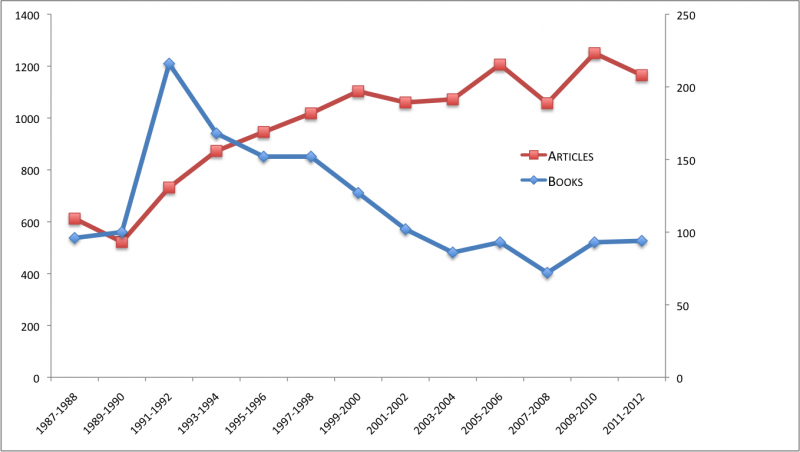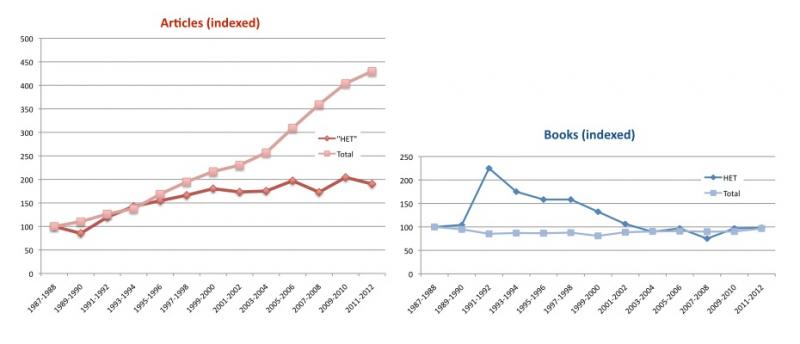In the past decade, the volume of literature in the history of economics has been of 500 articles and just under 50 books a year. The graph below traces the count in two year intervals (articles left axis, books right axis). The absolute volume is stable but given the growth of economic literature in the period, stable might be rebranded as static.

How much is this much? I know of no argument for the right proportion of fields in the literature of economics. In nature, there is no reason why one Linnean bracket should be equally numbered in specimens as the next. So too in the realms and genera of scholarship. In the biannual of 2011 and 2012, “Industry Studies” (L6, L7, L8 of JEL codes) records nearly three times as many articles in peer-reviewed journals but not as many books as the “History of Economic Thought” (JEL codes B1, B2, B3). Interesting, but meaningless. Perhaps a more meaningful comparison notes that the other “history” on the list, “Economic History”, records 1680 articles and 163 books against the 94 books and 1165 articles for the the “History of Economic Thought”. But then, is that good or bad? Is it surprising? Failing to find a competitor or a baseline I rather compare with the sum total of economic literature.
The articles in the history of economics nearly doubled in the period pictured, and the spurt happened in 1991-96. It is a supply side story. In 1993-4, the Journal of the History of Economic Thought became a quarterly, and the journals History of Economic Ideas, European Journal of the History of Economic Thought and History of Economics Review were created. The explosion of book titles in the early 1990s was similarly supply driven, or better stated as the “Elgar-Blaug effect”. The publisher Edward Elgar issued a flood of collected papers of the economics canon in response to the global growth of higher education and library budgets. That market has dried with google books and other digital collections meeting the demand, and history books returned to their mid 1980s threshold. In the same period book publishing in economics slightly decreased but the number of scholarly articles more than quadrupled. Since 2000, the history of economics has not kept up with the pace of scholarly article publication.

For 40 years, the history of economics has been a specialty and a subfield within economics. Craufurd Goodwin, who was one of the most dynamic leader-founders of this subfield/community, has argued that it followed a “golden age” at mid century when the giants of the economics dabbled in theory and history (a notion first proposed by Joseph Spengler in 1974). If I am permitted the liberty of over-interpreting my 26 data points, I believe they record the achievement of Goodwin’s generation that trained the scholars, and created the institutions that animate this literature.
The 1980 and 1990s were years of growth, in scholars and publication in the history of economics. There are no more prospects for growth.
Since I attended my first History of Economics Society conference in 2002, I have witnessed a few upheavals and some initiatives promising to redraw the intellectual landscape but none promising to expand the field. The creation of the Center for the History of Political Economy at Duke University has established itself as obligatory point of passage and the most visible node of the subdiscipline. INET has dedicated funding to historians of economics when none was available. Scholars in Europe have secured grants from Humanities and Social Science panels for short and mid-length research projects. A few more journals have appeared in Europe and are in a struggle to establish themselves. At the same time, the major North American graduate programs in the history of economics have either been shut down or are running at a trickle. The new cohort of scholars is mostly trained in Europe, with regular visits and friendly connections to North America (vide this blog, only one out of eight holds a US doctorate).
The promise of the 2000s and 2010s lies in changing the themes and practices of the discipline. The ambition is that in a few years time we might say confidently that the history of economics has became more exigent, compelling and consequential.



